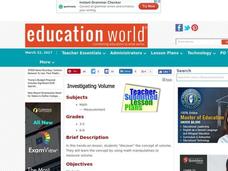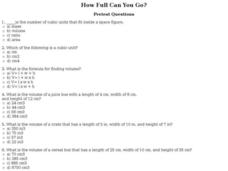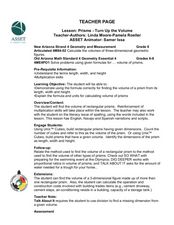Education World
Investigating Volume
Explore the concept of volume using unit cubes. Working individually or in small groups, your class measures with a ruler in inches and calculates the volume of various rectangular household boxes (provided by the teacher) and completes...
Curated OER
Ordering Sets of Measures
This isn't an ordinary number sequencing activity; as scholars put these values in order they must pay close attention to the units attached. Each set of numbers has different units of measurement, so they must convert to order them from...
Scholastic
Study Jams! Units of Measurement
As Mia and RJ discuss measurement, your class is introduced to the customary and metric systems for measuring mass, capacity, weight, and length. Temperature scales are also introduced. This resource can help set the foundation for later...
Curated OER
Geometry and Measurement
Young geometers explore relationships between units of measure and objects. Three activities provide varied opportunities to practice. Learners calculate the volume of two cylinders made by rolling a piece of paper vertically and...
Baylor College
Living Things and Their Needs: The Math Link
Enrich your study of living things with these cross-curricular math activities. Following along with the story Tillena Lou's Day in the Sun, learners will practice addition and subtraction, learn how to measure volume and length,...
Virginia Department of Education
Volume of a Rectangular Prism
Fill the minds of your young mathematicians. A hands-on activity has learners fill in a rectangular prism with unit cubes to determine its volume. the exercise provides a great hands-on way for learners to connect the activity...
Curated OER
The Amazing Inch and Measuring Up!
Fifth graders study the metric and customary systems of measuring length with rulers, meter / yardsticks, and tape measures. They determine area of polygons and surface area and volume of three-dimensional shapes. They list as many...
Curated OER
Measurement
Students create two prisms out of the same paper. They calcuate the number of centimeter cubes needed to fill each prism. They discover the concept of volume.
Curated OER
Units of Measurement
In this math worksheet, students study information about U.S. units of measurement and the equivalent metric units. Included are capacity, volume, area, mass and length. There are no problems on this page to do.
Curated OER
Volume Lab
How can we find volume if it a shape isn't easy to measure? Investigate methods for determining this as the volume of regular and irregular objects is explored in several stations. Learners discover that when the standard formula for...
Curated OER
Mind Your Pints and Quarts: Making Sense of Liquid Measurement
Elementary and middle schoolers identify different units of liquid measurement. They use the online Visual Thesaurus to learn about the relationships between units of liquid measurement.
Curated OER
Chemistry Lab-Molar Volume of Gas
Students determine the molar volume of hydrogen gas. In this molar volume lesson plan, students find the molar volume of hydrogen produced in a reaction between magnesium and hydrochloric acid. They use a eudiometer to measure the volume...
Sam Houston State University
How Full Can You Go? Pretest Questions
Ten questions regarding volume of rectangular prisms are presented to your geometers, most of them requiring the multiplication of length, width, and height. The assignment is acutally an interactive resource in that learners answer...
Curated OER
Measurement Tools
Which of these is the best tool for the job? Learners examine a measurement scenario and determine which of five tools would be the right choice. There is only one problem, and the worksheet includes pictures. Because the answer is...
Curated OER
Measure the Length of an Object
Every measuring job requires a tool, but which is the right one? Scholars read four measuring tasks and select the proper tool for each. Next, they switch the exercise by choosing from a list of measuring tasks given a tool. Note there...
Curated OER
Perimeter, Area or Volume?
In this perimeter, area and volume worksheet, 5th graders solve 6 word problems, then tell whether they found perimeter, area or volume.
Curated OER
Measure the Length of an Object
Would you measure ice water with a different tool than the height of a door? Of course! Scholars examine five measuring tasks and match them to the proper tools for the job. Three of these are length scenarios, one volume, and the last...
Curated OER
Length, Perimeter, and Area
Pupils explore the concepts of length, perimeter, and area. In this math lesson, students use Shape Explorer to practice finding length, perimeter, and area.
Curated OER
Measure the Length of an Object
Which of these tools would work best? As scholars learn about measuring, be sure they know the proper tool for the job. There are three multiple-choice questions here prompting pupils to determine proper tool-measurement pairs. Would...
Curated OER
Volume and Density Worksheet
All 20 of the problems on the worksheet involve the computation of cubic volume or density. As long as your young scientists can apply the appropriate mathematical formulas, they will succeed in solving these problems. They are not...
Curated OER
Measure Twice, Cut Once
Elementary schoolers learn about metric units and how they are used by engineers. They learn how engineers use the units to measure mass, distance, and volume. Then, they estimate measurements of units, and compare them to actual...
Curated OER
Prisms-Turn Up The Volume
Identify the length, width, and height of prisms. Critical thinkers calculate the volume of prisms given small amounts of information. They derive the formula given the length, width and height.
University of Houston
Volume for Rectangular Prisms
Upper graders define perimeter and area of a rectangle, estimate numbers of cubes and determine the maximum amount that will fit in a given space. In this math lesson, pupils complete related worksheet, build prisms and find volume and...
Curated OER
Area and Volume
Use this geometry review worksheet to have learners complete nine problems involving transformations, area, volume, and unit conversions. They answer one multiple choice question on estimating lengths.

























